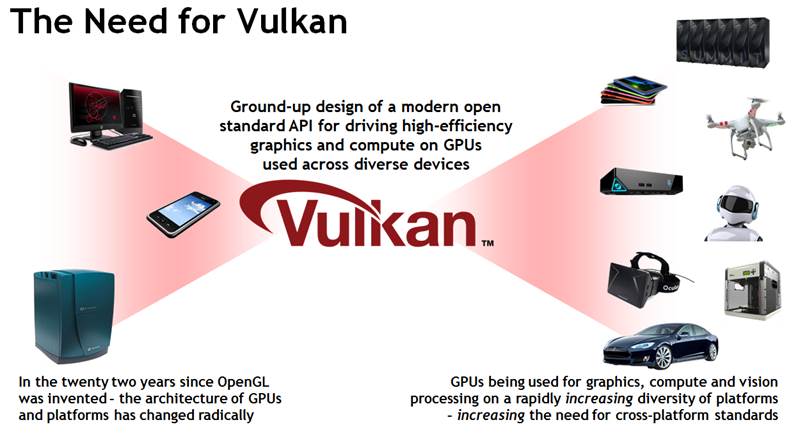Vulkan Replaces AMD's Mantle In 3DMark API Overhead Test
Futuremark replaced AMD's Mantle with the Khronos Group's Vulkan API in the 3DMark API Overhead test. This will make it easier for developers to compare DirectX 11, DirectX 12, and Vulkan performance while also highlighting the growing popularity of Khronos' relatively new graphics API.
Vulkan was announced in March 2015 and quickly became popular with PC and mobile game developers alike. Khronos said at GDC 2017 that major GPU companies like AMD, Intel, and Nvidia are releasing drivers with Vulkan support and that more game devs are starting to take advantage of Vulkan's capabilities. (The API is already supported by popular games like Doom and Dota 2 and is core to the Nintendo Switch console and Android platform.)
Now it will be easier for those devs to see how Vulkan compares to DirectX 11 and DirectX 12. As Futuremark said in its announcement:
Vulkan is a new graphics API that provides high-efficiency, low-level access to modern GPUs in a wide variety of devices from PCs to smartphones. APIs like Vulkan and DirectX 12 make better use of multi-core CPUs to streamline code execution and eliminate software bottlenecks, particularly for draw calls. Games typically make thousands of draw calls per frame, but each one creates performance-limiting overhead for the CPU. Vulkan and DirectX 12 reduce that overhead, which means more objects, textures and effects can be drawn to the screen.
The 3DMark API Overhead test makes increasing numbers of draw calls per second to quantify the performance of each API. This lets developers know how an API will perform on a given system--Futuremark was careful to note that the API Overhead test "is not a general-purpose GPU benchmark" and "should not be used to compare graphics cards from different vendors." But it can still prove useful for anyone considering these graphics APIs.
The updated API Overhead test is now included with 3DMark Advanced Edition and 3DMark Professional Edition; it's not baked in to the utility's Basic Edition or the demo available via Steam. Vulkan itself is supported by many platforms--and don't worry, its multi-GPU support isn't limited to Windows 10, like some people thought after a few confusing presentations at GDC 2017.
Get Tom's Hardware's best news and in-depth reviews, straight to your inbox.

Nathaniel Mott is a freelance news and features writer for Tom's Hardware US, covering breaking news, security, and the silliest aspects of the tech industry.
-
alextheblue This was inevitable. Vulkan was built on Mantle, and has essentially superseded it.Reply -
vaughn2k ... And Vega is coming, that is built around Vulkan. AMD's strategy is working as planned..Reply -
junkeymonkey maybe being next generation OpenGL that will help loosen microsofts strangle hold on PC games and make them far better Linux friendlyReply
if anything can help cut my ties with windows I'm all for it
too bad someone like John Carmack is not still around to take advantage of this as he did with OpenGL in his id games . we know how Linux friendly they were .
